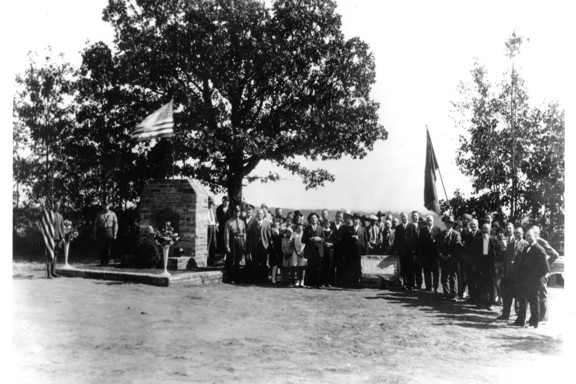|

On October
19, 1929, the Trading Ford Monument was dedicated by the N. C.
Historical Commission (now Archives and History) and citizens of
Davidson county. It was situated on a 1.1 acre tract donated by
Tallassee Power Company (now Alcoa) at the intersection of the
Trading Ford and Yadkin Ford roads. A remnant of the Trading Ford
Road still lies beneath the ivy to the south of the monument. The
Old Salisbury Road occupies the position of the old Yadkin Ford Road
in front of the monument.
The Monument
commemorates General Nathanael Greene's “Providential” crossing
of the Yadkin River just ahead of Lord Cornwallis' pursuing British
army, February 2 – 4, 1781. Beginning at the close of the Battle
of Cowpens, January 17, 1781, the British pursued the American army
in “cat and mouse” fashion over 200 miles of the heart of North
Carolina to the Dan River in Virginia, before finally meeting at the
Battle of Guilford Courthouse on March 15th.
At the
Yadkin River, Generals Greene and Daniel Morgan spent the better part
of two days ferrying boats back and forth across the river, moving
their army of 1800, the Salisbury Military District stores, fleeing
civilians who crowded the roads, and the Cowpens prisoners across the
river. By the end of the day of February 3rd, all were
across except for a small party of Virginia and North Carolina
militia. At dusk according to one account, midnight in another, the
vanguard of the British army were silhouetted against the sky as they
rode over the crest of a hill near a small branch. Greene's militia
engaged them, exchanging several rounds before slipping away under
cover of dark and crossing the river two miles farther down. “Two
of the militia were killed; the loss of the enemy was not known, but
from appearances of blood in different places, believed to be ten or
twelve. ... After the firing ceased, the British marched on to the
river, but found the water was too deep to ford, and still rising,
and that General Morgan, encamped on the other side, had with him all
the boats and canoes." (General Joseph Graham) The British
captured the wagons, which “Bloody” Tarleton described as
"waggons and stores belonging to country people."
On
February 4th, the entire British army, estimated at between 2500 and
3000, reached the south bank of the Yadkin. Cornwallis was eager to
engage Greene's army, but was separated from them by the width of the
swollen river. He installed his artillery atop the nearest bluff of
the "Heights of Gowerie", and furiously cannonaded the
opposite shore. According to Dr. William Read's eye-witness account,
the American Southern Commander had taken up quarters in a cabin not
far from the river. He tended to correspondence while cannon balls
flew about him. Unable to cross the river at the Trading Ford, the
British returned to Salisbury and marched 40 miles north to cross the
Yadkin at the Shallow Ford.
The
Race to the Dan River, including the events at the Trading Ford, was
given highest national significance in the National Park Service
Report
to Congress on the Historic Preservation of Revolutionary War and War
of 1812 Sites in the United States
in 2008. The American forces had lost two armies in the South, one
at Charleston in May 1780, the second at Camden in August of the same
year. The loss of a third, which was narrowly averted on the banks
of both the Yadkin and Dan Rivers, could have ended the war in
Britain's favor. Instead, eight months later, Cornwallis surrendered
to Washington at Yorktown, and American independence was won.
|